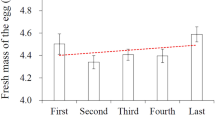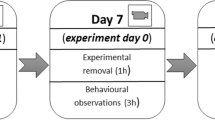Summary
This study presents the first direct evidence of benefit derived from the male's parental effort during rearing of young in a monogamous, precocial bird species. We compared mothers accompanied by a mate (paired mothers) with single mothers, some of which were artificial widows, in a semicaptive flock of bar-headed geese (Anser indicus). Paired mothers were less often displaced by other birds and suffered fewer interruptions of brooding. Their goslings spent more time grazing and survived with a higher probability. Although one beneficial result of the male's parental effort may be the continued availability and survival of his mate, a more direct benefit arises from higher offspring survival between hatching and fledging.
Similar content being viewed by others
References
Ankney CD (1980) Egg weight, survival, and growth of lesser snow goose goslings. J Wildl Manage 44:174–182
Bart J, Tornes A (1989) Importance of monogamous male birds in determining reproductive success. Evidence for house wrens and a review of male-removal studies. Behav Ecol Sociobiol 24:109–116
Black JM, Owen M (1989) Parent-offspring relationships in wintering barnacle geese. Anim Behav 37:187–198
Boyd H (1953) On encounters between wild white-fronted geese in winter flocks. Behaviour 5:85–129
Dementiew GP, Gladkow NA (ed) (1967) Birds of the Soviet Union, vol 4. U.S. Department of International Natural Science Foundation Washington DC
Dittami JP (1981) Seasonal changes in the behavior and plasma titers of various hormones in bar-headed geese, Anser indicus. Z Tierpsychol 55:289–324
Erckmann WJ (1983) The evolution of polyandry in shorebirds: an evaluation of hypotheses. In: Wasser SK (ed) Social behavior of female vertebrates. Academic Press, New York, pp 113–168
Gole P (1982) Status of Anser indicus in Asia with special reference to India. Aquila 89:141–149
Hannon SJ (1984) Factors limiting polygyny in the willow ptarmigan. Anim Behav 32:153–161
Kydyraliew J (1967) Die Streifengans (Anser indicus) im Tienschan Gebirge (Translated from Russian). Ornithologija 8:245–253
Lamprecht J (1986a) Structure and causation of the dominance hierarchy in a flock of bar-headed geese (Anser indicus). Behaviour 96:28–48
Lamprecht J (1986b) Social dominance and reproductive success in a goose flock (Anser indicus). Behaviour 97:50–65
Lamprecht J (1987) Female reproductive strategies in bar-headed geese (Anser indicus): why are geese monogamous? Behav Ecol Sociobiol 21:297–305
Lamprecht J, Buhrow H (1987) Harem polygyny in bar-headed geese. Ardea 75:285–292
Lazarus J, Inglis IR (1978) The breeding behaviour of the pinkfooted goose: parental care and vigilant behaviour during the nesting period. Behaviour 65:62–88
Lessells CM (1986) Brood-size in Canada geese: a manipulation experiment. J Anim Ecol 55:669–689
Lessells CM (1987) Parental investment, brood-size and time-budgets: behaviour of lesser snow geese families (Anser c. caerulescens). Ardea 75:189–203
Madsen J (1981) Post hatching behaviour of families and nonbreeding Greenland white-fronted geese. In: Fox AD, Stroud DA (eds) Report of the 1979 Greenland white-fronted goose study expedition to Edalungmiut Nunat, West Greenland. Aberystwyth, pp 116–122
Martin K, Cooke F (1987) Bi-parental care in willow ptarmigan: a luxury? Anim Behav 35:369–379
Martin K, Cooch FG, Rockwell RF, Cooke F (1985) Reproductive performance in lesser snow geese: are two parents essential? Behav Ecol Sociobiol 17:257–263
Owen M (1972) Some factors affecting food intake and selection in white-fronted geese. J Anim Ecol 41:79–92
Owen M, Black JM (1989) Factors affecting survival of barnacle geese on migration from the breeding grounds. J Anim Ecol 58:603–617
Owen M, Black JM, Liber H (1987) Pair bond duration and timing of its formation in barnacle geese (Branta leucopsis). In: Weller M (ed) Waterfowl in winter. University of Minnesota Press, Minneapolis, pp 23–28
Raveling DG (1970) Dominance relationships and agonistic behavior of Canada geese in winter. Behaviour 37:291–319
Schäfer E (1938) Ornithologische Ergebnisse zweier Forschungsreisen nach Tibet. J Ornitol 86:1–349
Schindler M (1983) Die intrafamiliären Abstandsverhältnisse und ihre Auswirkungen auf Gössel and Elternverhalten bei Streifengänsen (Anser indicus). Diplomarbeit, Universität München
Schindler M, Lamprecht J (1987) Increase of parental effort with brood-size in a nidifugous bird. Auk 104:688–693
Schlafer A (1983) Weibliche Brutpflegeverhaltensweisen bei Männchen der Gänsearten Anser anser und Anser indicus. Vogelwarte 32:149–150
Scott DK (1980) Functional aspects of prolonged parental care in Bewick's swans. Anim Behav 28:938–952
Stroud DA (1982) Observations on the incubation and posthatching behaviour of the Greenland white-fronted goose. Wildfowl 33:63–72
Thompson SC, Raveling DG (1987) Incubation behaviour of emperor geese compared with other geese: interactions of predation, body-size and energetics. Auk 104:707–716
Wickler W, Seibt U (1981) Monogamy in crustacca and man. Z Tierpsychol 57:215–234
Willson MF (1966) Breeding ecology of the yellow-headed blackbird. Ecol Monogr 36:51–77
Author information
Authors and Affiliations
Rights and permissions
About this article
Cite this article
Schneider, J., Lamprecht, J. The importance of biparental care in a precocial, monogamous bird, the bar-headed goose (Anser indicus). Behav Ecol Sociobiol 27, 415–419 (1990). https://doi.org/10.1007/BF00164068
Received:
Accepted:
Issue Date:
DOI: https://doi.org/10.1007/BF00164068




